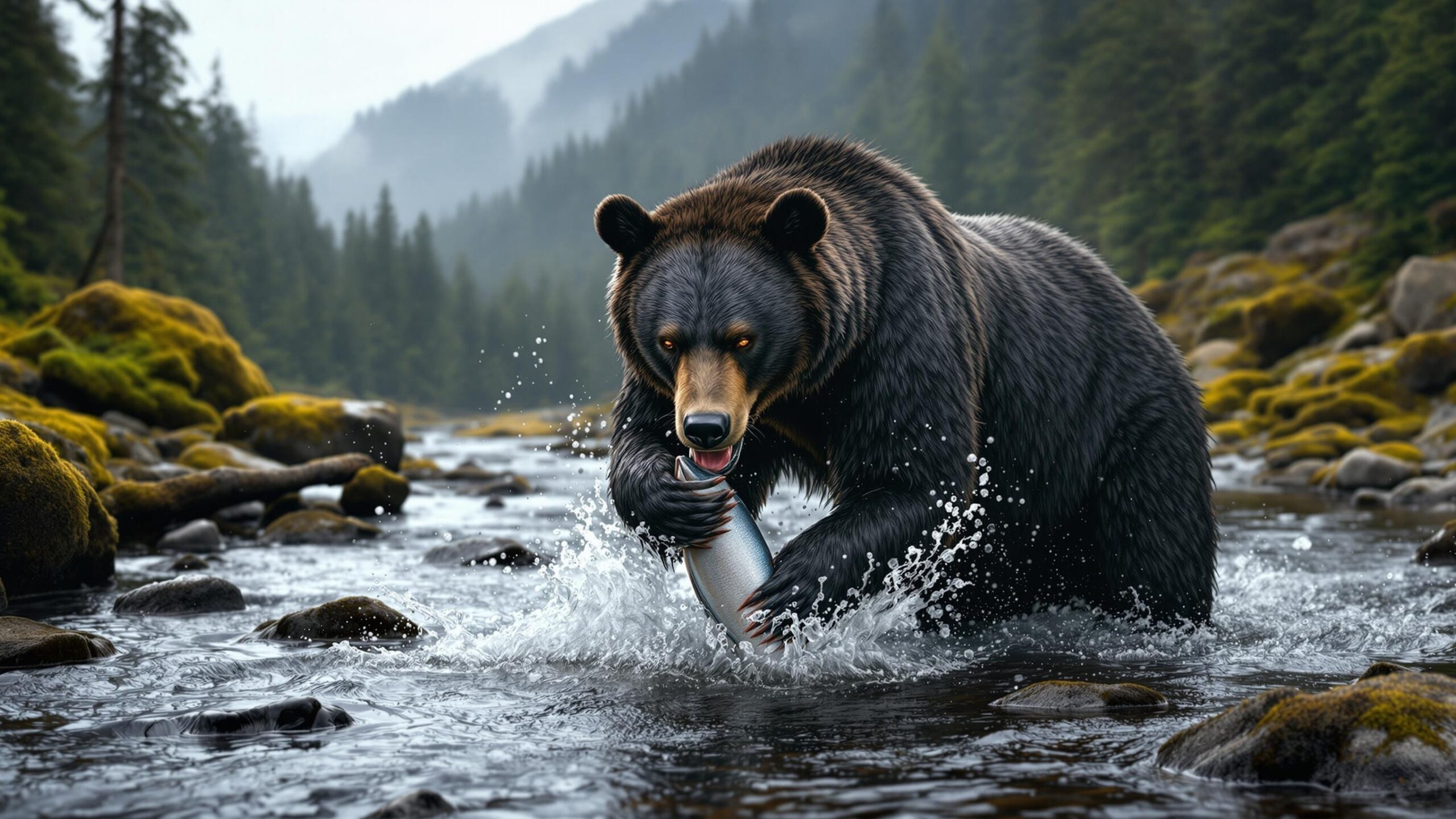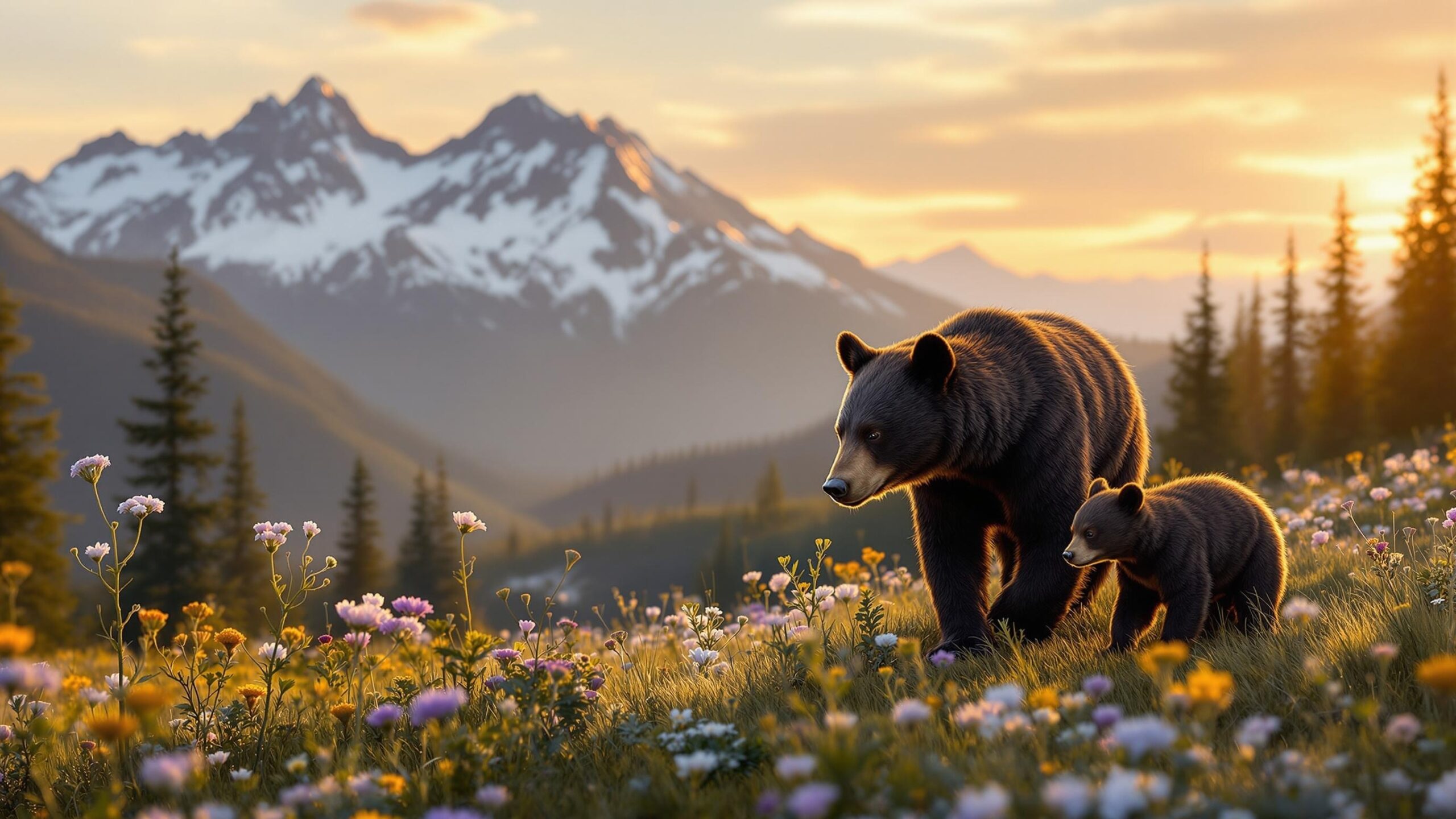Olympic Black Bear (Ursus americanus altifrontalis): The Shadow of the Rainforest
Hidden within the lush, misty old-growth forests of the Pacific Northwest, a secretive and charismatic creature quietly roams—strong, silent, and seldom seen. The Olympic Black Bear (Ursus americanus altifrontalis), a subspecies of the American black bear, is a uniquely adapted inhabitant of the Olympic Peninsula in Washington State. These bears thrive in one of North America’s most distinct ecosystems: the temperate rainforest, where centuries-old trees, ceaseless rainfall, and rich biodiversity create a landscape both enchanting and formidable.
A symbol of wild solitude and ecological balance, the Olympic Black Bear is more than just a regional variant. It plays a crucial role in the health of its forest home and serves as a biological bridge between land and sea, trees and soil, predator and prey. This article provides a comprehensive exploration of the Olympic Black Bear—from its distinctive features and behaviors to its ecological importance, and its future in an increasingly human-shaped world.
Physical Appearance: Built for the Wild
At first glance, the Olympic Black Bear might appear similar to other American black bears found throughout the continent. However, closer observation reveals several physical traits that set this subspecies apart. Bears in the Olympic region tend to be slightly larger and more robust, thanks in part to the region’s rich food sources and long growing season. Adult males, or boars, can weigh between 250 to 600 pounds, with some exceptionally large individuals surpassing this range during peak foraging periods. Females, or sows, generally weigh between 150 to 300 pounds. Their fur is usually deep black and sleek, although occasional variations in shade do occur.
The thick, water-resistant coat is ideal for the Olympic Peninsula’s wet climate. A keen sense of smell, small but expressive eyes, and rounded ears give the bear an appearance that balances power with a surprising degree of alertness and intelligence. Olympic Black Bears have shorter claws compared to grizzly bears but are formidable diggers and climbers nonetheless. Their overall structure, from muscular limbs to plantigrade feet (flat-footed like humans), is perfectly suited for navigating steep slopes, fallen logs, and the tangle of rainforest undergrowth.
Geographic Range: Heart of the Olympic Peninsula
As the name implies, Olympic Black Bears are found almost exclusively in the Olympic Peninsula of northwestern Washington State. Their range includes Olympic National Park, the Olympic National Forest, and surrounding remote wilderness zones. This region is ecologically rich and geographically isolated, surrounded by the Pacific Ocean to the west, the Strait of Juan de Fuca to the north, and Puget Sound to the east.
This relative isolation has allowed the Olympic Black Bear population to evolve with minimal genetic input from other black bear populations, leading to subtle but distinct differences in size, behavior, and diet. The habitat within the peninsula ranges from lowland temperate rainforests with towering Sitka spruce and western hemlock, to subalpine meadows and rugged highlands. These forests offer the bear abundant food and shelter, while also serving as one of the last true sanctuaries for large mammals in the contiguous United States.
Habitat: Life in a Temperate Rainforest
The Olympic Peninsula is home to one of the world’s few remaining temperate rainforests, and it’s here that the Olympic Black Bear thrives. Unlike their cousins in more arid or boreal zones, these bears live in a moist, densely vegetated environment where annual rainfall can exceed 140 inches in some areas. Towering trees, thick ferns, moss-draped branches, and abundant undergrowth provide both cover and a diverse food base. Deadfall and hollow logs offer denning sites, while the sheer abundance of plant life—augmented by salmon runs and invertebrate populations—supports a stable food web.
Because the ecosystem is relatively intact and protected by federal law, Olympic Black Bears have access to an unusually pristine range. That said, they are still influenced by seasonal changes. In spring, they may descend to lower elevations to forage on emerging vegetation. In summer and early fall, they range widely in search of berries, insects, and spawning fish. When winter approaches, they seek high-elevation dens or hollow trees for hibernation.

Diet: Foragers of Abundance
Olympic Black Bears are opportunistic omnivores with a diverse and adaptable diet. Thanks to the fertile and wet environment, these bears have access to a smorgasbord of seasonal food options. During the spring and early summer, they feed heavily on emerging shoots, grasses, roots, and nutrient-rich plant matter. They are also fond of insects such as ants, grubs, and termites, which they dig out of rotting logs or soil.
One of the most significant food sources for Olympic Black Bears is Pacific salmon. When the fish return to spawn in the region’s countless streams and rivers, the bears take full advantage. Salmon provide an unmatched protein and fat boost, essential for pre-hibernation fattening. Bears may fish for hours, carrying their catches into the woods, often leaving nutrient-rich carcasses to decompose into the forest floor—thus fertilizing the very trees that shade them.
Berries such as salmonberries, huckleberries, and salal make up another major portion of their diet during late summer and fall. These fruits are not only energy-dense but also help bears build up fat reserves for the winter. Although carnivorous predation is rare, Olympic Black Bears will scavenge or occasionally take down small mammals or newborn deer if the opportunity arises.
Behavior and Social Structure: Solitary But Sophisticated
Like most black bears, Olympic Black Bears are primarily solitary animals, except for females with cubs or brief interactions during the mating season. Each individual maintains a home range that may overlap with others, but direct encounters are generally avoided through keen scent detection and avoidance behavior. These bears are crepuscular, meaning they are most active during dawn and dusk. However, in remote areas with minimal human presence, they may also be active throughout the day.
Their intelligence and memory are highly developed; bears remember fruitful foraging sites and may revisit successful berry patches or salmon runs year after year. In the fall, Olympic Black Bears enter a state known as hyperphagia, during which they dramatically increase food intake to build up fat stores for winter hibernation. By late autumn, they retreat to dens, which may be found under root masses, in hollow logs, or in natural caves. Once inside, their metabolic rate drops significantly, allowing them to survive for months without eating, drinking, or defecating.
Reproduction: The Slow Rhythm of the Forest
The mating season for Olympic Black Bears typically spans from May through July. Males roam wide ranges in search of females in estrus, but competition is fierce, and only the largest or most experienced boars typically breed. After mating, a fascinating biological process occurs known as delayed implantation. The fertilized egg does not immediately implant in the uterus. Instead, it remains in a dormant state until the female enters hibernation. Only if she has sufficient fat reserves will the embryo implant and begin to grow.
Cubs are born during winter hibernation, usually between January and February. Litters typically consist of one to three cubs. At birth, they are blind, toothless, and no larger than a soda can, weighing less than a pound each. They nurse in the den until spring, when mother and cubs emerge. The young remain with their mother for about 18 months, learning to forage, navigate terrain, and avoid danger before setting off on their own.
Communication and Intelligence: Quiet but Not Silent
Although not vocal animals by nature, Olympic Black Bears communicate through a blend of vocal sounds, scent marking, and body language. Cubs may whimper, squeal, or grunt when in distress or seeking attention, while adults may emit huffs, growls, or jaw-popping sounds when threatened or alarmed. These sounds, combined with posture—such as standing upright or swaying—can serve as warning displays or expressions of curiosity. Much of a bear’s communication is chemical. By rubbing against trees, clawing bark, or urinating on scent posts, bears convey important messages about their presence, reproductive status, or territorial boundaries. These subtle yet sophisticated signals help avoid unnecessary conflict in the dense and shadowy woods of the peninsula.
Human Interactions: Rare but Growing
Olympic Black Bears are naturally wary of humans and typically avoid contact. However, as recreational use of wild areas increases and human development creeps closer to bear habitat, interactions are becoming more common. Most encounters are benign—brief glimpses along hiking trails or distant sightings across alpine meadows—but problems can arise when bears become food-conditioned. Trash, pet food, unprotected campsites, and poorly stored food in vehicles or cabins can attract bears, potentially leading to property damage or public safety concerns. Conservation groups and park authorities emphasize the importance of “bear-aware” behavior: securing food in bear-proof containers, keeping campsites clean, and never approaching or feeding bears.
Conservation Status: Stable But Watchful
As a subspecies of the American Black Bear, the Olympic Black Bear is currently considered “Least Concern” by the IUCN Red List. Thanks to the protection offered by Olympic National Park and surrounding wilderness areas, their population remains healthy and stable. However, their restricted geographic range makes them vulnerable to sudden environmental or political changes.
Key conservation concerns include habitat fragmentation, increased road access, and climate-related shifts in food availability. Maintaining habitat connectivity, enforcing wilderness protections, and continuing public education efforts are essential to ensuring the long-term viability of this unique bear population. Research on Olympic Black Bears is ongoing, with scientists studying their genetics, movement patterns, and ecological roles. Such work is vital for tracking changes over time and making informed conservation decisions.

Role in the Ecosystem: Keystone of the Forest
Olympic Black Bears are considered keystone species, meaning their presence and behavior have outsized effects on the ecosystem. By spreading seeds through their scat, dragging salmon carcasses into the forest, and disturbing soil while digging, bears contribute to forest regeneration, nutrient cycling, and overall biodiversity. Their foraging also helps shape plant communities, particularly when they consume large quantities of fruit and disperse seeds across wide areas. As scavengers, they help clean up dead animals, reducing the spread of disease. And as apex omnivores, they help regulate populations of smaller animals and insects, contributing to ecological balance.
Bear Viewing and Ecotourism: A Glimpse Into the Wild
While Olympic Black Bears are elusive, they are sometimes seen by lucky hikers or wildlife photographers exploring Olympic National Park. Areas like the Hoh Rainforest, Sol Duc Valley, and alpine trails near Hurricane Ridge are all potential viewing locations—especially in the early morning or late evening during berry season. Wildlife viewing, when done respectfully, helps foster a deeper appreciation for the natural world and supports local conservation economies. Visitors are encouraged to maintain a safe distance, use binoculars or long lenses, and never interfere with natural bear behavior.
The Quiet Monarch of the Mossy Kingdom
The Olympic Black Bear is a remarkable creature—a living embodiment of the Pacific Northwest’s wild soul. With its silent strength, deep intelligence, and ancient lineage, it reminds us of the quiet complexity that thrives in the shadows of old-growth trees and mountain mists. As we move deeper into the 21st century, the Olympic Peninsula remains a rare and precious example of ecological harmony. The bear, ever watchful, ever wandering, stands as both guardian and beneficiary of this balance. By protecting the bear, we protect the forest; and in doing so, we preserve one of the last true wild places left in the lower forty-eight.

